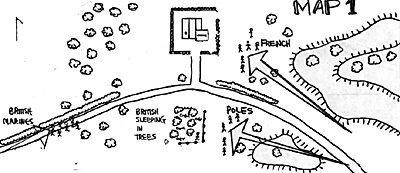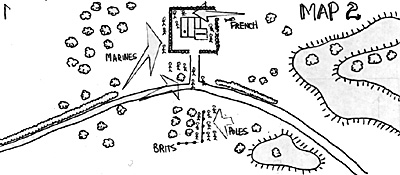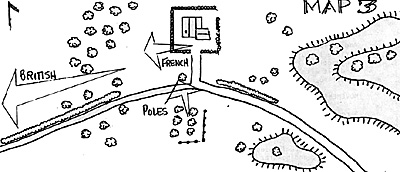I had been introduced to the 'PW Review' by the Stone Mountain gang, and had read all their back copies. "Look here guys," I said. "This here Wally Simon sure writes like these games are fun. He plays man-to-man skirmish games."
"Sounds great!" they said.
"The movement is controlled by cards." I said.
"No way!" they said.
I had also recently acquired a copy of Donald Featherstone's 'Skirmish Wargaming'. With a venerable name like that, how could we go wrong?
I painted up two dozen British and French Napoleonic figures, then set out to learn the rules. Thew require that orders be written each turn for each figure, detailing moves, actions, etc. We tried a couple of skirmishes to get the feel of them and, hopefully / to weed out problems. A rule requiring a man to proceed on sequential turns from walk, to jog, to run was dropped after one of our participants was noticed moving his men in circles.
"What are you doing?" we asked.
"Building up speed to charge," he said.
We agreed that wasn't necessary.
The first full-fledged scenario was at our monthly club meeting. The scenario was simple. A British patrol of 7 men had come upon a monastary with a cellar full of wine. The 6 soldiers were left to "guard' it while the callow Lt. Ffolkes went back to get some help to take away the wine. The soldiers began to drink, and all but one fell asleep in the warm noonday sun.
 At this point, 6 Polish grenadiers, 5 French grenadiers and one sapper
appear to the East. Two turns later, 5 British marines and Lt. Ffolkes
appeared on the road to the West. (MAP 1)
At this point, 6 Polish grenadiers, 5 French grenadiers and one sapper
appear to the East. Two turns later, 5 British marines and Lt. Ffolkes
appeared on the road to the West. (MAP 1)
The French began by shooting two of the British among the trees where they were trying to scramble to their feet. Fire is resolved by allotting a basic 80% chance of hitting and deducting for various things such as cover, range, movement and wounds. The actual number rolled, if a hit, is cross-referenced to a table that tells what type of wound is received. These range from minor wounds that incapacitate for 2 rounds, to heavy body wounds that incapacitate for 10 rounds and affect actions for the rest of the game. Multiple wounds incapacitate consecutively so 2 minor wounds put you down for 4 turns.
While some Poles rushed the men in the woods, the French went after the wine. They rushed the monastary opposed by 3 British. Two French got hit in the initial rush by musket fire, but the rest were coming around the back of the monastary. (MAP 2)
 Meanwhile, the marines were presenting a daunting appearance as
they trotted down the road in formation.
Meanwhile, the marines were presenting a daunting appearance as
they trotted down the road in formation.
As they reached the monastary, three went to the wall and commenced firing at close range into the French. The other two, led by the Lieutenant, waded in for a hand-to-hand punchup.
Hand-to-hand cross references the weapons, and assigns a chance to hit to each man. All were equal (musket with bayonet) except the officer, whose sword was better than a bayonet, and the sapper's axe, a truly fearsome weapon.,
Several men were wounded on each side, with the British marginally getting the better fit due to the fire of the marines behind the wall. The Lieutenant stepped up to fight the sapper, full of confidence as he could see a marine aiming at the sapper's back.
At that time, a previously wounded and knocked down French private was plotted to stand up, right in the line of fire. 'Bang!' He falls back down. 'Thwack!' The axe cleaves the lieutenant. Heartened by this, and suddenly reinforced by the Poles who had been mopping up the woods, the French launched their final assault. The result was the remainder of the British routing from the field, leaving several dead and wounded and of course, the wine. (MAP 3)
 The rules leave a lot open for the judge to interpret. If a
person wants to do an unusual action, the judge has to assign a Percentage
chance of success and roll the dice. In early skirmishes, where only I
knew the rules, this posed a little problem. Later, people tended to argue
and the simple, fun skirmish took an the appearance of a heated debate. (I
always wondered why Wally always changed the rules for each new game.)
The rules leave a lot open for the judge to interpret. If a
person wants to do an unusual action, the judge has to assign a Percentage
chance of success and roll the dice. In early skirmishes, where only I
knew the rules, this posed a little problem. Later, people tended to argue
and the simple, fun skirmish took an the appearance of a heated debate. (I
always wondered why Wally always changed the rules for each new game.)
We ran 2 ACW skirmishes with these Wes at Origins, and everyone seemed to have a good time. Again, only we knew the rules and no- one offered serious argument.
My next project is to try the Famous Simon Card-Based Movement System, world reknowned (except in Annapolis), as soon as I can talk. the locals into trying it.
Back to PW Review April 1985 Table of Contents
Back to PW Review List of Issues
Back to MagWeb Master Magazine List
© Copyright 1985 Wally Simon
This article appears in MagWeb (Magazine Web) on the Internet World Wide Web.
Other military history articles and gaming articles are available at http://www.magweb.com